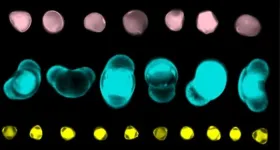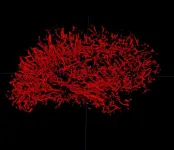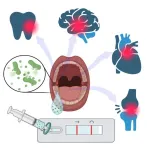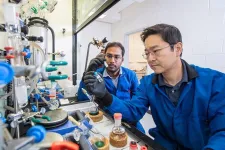(Press-News.org) An emerging system which combines rapid imaging with artificial intelligence could help scientists build a comprehensive picture of present and historic environmental change – by swiftly and accurately analysing pollen.
Pollen grains from different plant species are unique and identifiable based on their shape. Analysing which pollen grains are captured in samples such as sediment cores from lakes helps scientists understand which plants were thriving at any given point in history, potentially dating back thousands to millions of years.
Up to now, scientists have manually counted pollen types in sediments or from air samples using a light microscope – a specialised and time-consuming task.
Now, scientists at the University of Exeter and Swansea University are combining cutting-edge technologies including imaging flow cytometry and artificial intelligence to build a system capable of identifying and categorising pollen at much faster rates. Their progress is published today in a research paper in New Phytologist. As well as building a fuller picture of past flora, the team hope the technology could one day be applied to more accurate pollen readings in today’s environment, which may help provide hayfever sufferers to mitigate symptoms.
Dr Ann Power, of the University of Exeter, said: “Pollen is an important environmental indicator, and piecing together the jigsaw of different pollen types in the atmosphere, both today and in the past, can help us build up a picture of biodiversity and climate change.
“However, recognising what plant species pollen belongs to under a microscope is incredibly labour-intensive and cannot always be done. The system we’re developing will cut the time this takes dramatically and improve classifications. This means we can build a richer picture of pollen in the environment far more swiftly, revealing how the climate, human activity and biodiversity has changed over time, or better understand what allergens are in the air we breathe.”
The team has already used the system to automatically analyse a 5,500-year-old slice of lake sediment core, rapidly classifying over a thousand pollen grains. In the past, this would have taken a specialist up to eight hours to count and categorise – a task the new system completed in well under an hour.
The new system uses imaging flow cytometry – a technology which is typically used to investigate cells in medical research, to quickly capture pollen images. A unique type of artificial intelligence has then been developed based on deep learning to identify the different types of pollen in an environmental sample. This is able to make these distinctions even when the sample is imperfect.
Dr Claire Barnes, from Swansea University, said: “Up to now, the AI systems in development to categorise pollen learn from and test on the same pollen libraries – which means each sample is perfect and belongs to species previously seen by the network. These systems are not able to recognise pollen from the environment that’s taken some knocks along the way, nor to categorise pollen not included in training libraries. Incorporating a unique version of deep learning into our system means the artificial intelligence is smarter and applies a more flexible approach to learning. It can deal with poor quality images and can use shared species characteristics to predict what family of plant the pollen belongs to even if the system hasn’t seen it before during training.”
In the coming years, the team hopes to refine and launch the new system, and to use it to learn more about grass pollen, a particular irritant for hayfever sufferers. Dr Power said: “Some grass pollens are more allergenic than others. If we can understand better which pollens are prevalent at specific times, it would lead to improvements in the pollen forecast that could help people with hayfever plan to reduce their exposure.”
The research is supported by the National Environment Research Council (NERC) and the US National Institutes of Health. The paper is entitled ‘Deductive Automated Pollen Classification in Environmental samples via Exploratory Deep Learning and Imaging Flow Cytometry’, and is published in New Phytologist.
END
Artificial intelligence could help build pollen jigsaw of present and ancient flora
2023-09-08
ELSE PRESS RELEASES FROM THIS DATE:
Distance from clinic influences abortion pill access
2023-09-08
Women who live farther from a medical clinic and those who identify as multiracial are more likely to use telemedicine to get abortion pills than to visit a clinic, according to a new study by researchers at the University of Washington School of Medicine.
The findings were published Sept. 1 in JAMA Network Open.
“One of the main takeaways,” said lead author Anna Fiastro, a family medicine research scientist at UW Medicine, “is that the further patients are from a brick-and-mortar clinic, the more ...
Study links epigenetic changes to historic trauma in Alaska Native communities
2023-09-08
CHAMPAIGN, Ill. — Researchers investigated the relationship between historical traumatic events experienced by Alaska Native communities and epigenetic markers on genes that previous studies have linked to trauma. The new study found a similar pattern among Alaska Native participants, with specific epigenetic differences observed in those who reported experiencing the most intense symptoms of distress when reflecting on historic losses.
The study also found that individuals who strongly identified with their Alaska Native heritage and participated in cultural activities generally reported better well-being. The new findings are detailed in the International ...
Mums exposed to air pollution give birth to smaller babies, but living in a greener area may mitigate the risks
2023-09-08
Milan, Italy: Women exposed to air pollution give birth to smaller babies, according to research that will be presented at the European Respiratory Society International Congress in Milan, Italy [1]. The research also shows that women living in greener areas give birth to bigger babies and this may help counteract the effects of pollution.
There is a strong relationship between birthweight and lung health, with low birthweight children facing a higher risk of asthma and higher rates of chronic obstructive ...
Stevens INI receives new funding to study small vessel disease in Asian Americans
2023-09-07
Asian Americans are among the fastest growing populations in the U.S. but are significantly underrepresented in Alzheimer’s disease and related dementias (ADRD) research. This means there is a significant knowledge gap of ADRD in this particular group at a time when the global Asian population is rapidly aging and the burden of ADRD will likely mirror this growth. Thanks to a new award, the Keck School of Medicine of USC’s Mark and Mary Stevens Neuroimaging and Informatics Institute (Stevens INI) is perfectly poised to help bridge the gap.
Professor of ...
What’s love got to do with it? An exception to the recognition of musical themes
2023-09-07
New Haven, Conn. — Music can take on many forms in cultures across the globe, but Yale researchers have found in a new study that some themes are universally recognizable by people everywhere with one notable exception — love songs.
“All around the world, people sing in similar ways,” said senior author Samuel Mehr, who splits his time between the Yale Child Study Center, where he is an assistant professor adjunct, and the University of Auckland, where he is senior lecturer in psychology. “Music is deeply rooted in human social interaction.”
For ...
Neurodivergent engineering research at USU funded by the National Science Foundation
2023-09-07
More will soon be known about neurodiversity in engineering students, thanks to funding from the National Science Foundation and the efforts of Utah State University College of Engineering Assistant Professor Marissa Tsugawa.
Tsugawa, along with collaborators from USU and Minnesota State University, received $373,508 in funding for their research in identifying emancipatory language and capturing neurodivergent narratives.
“The term neurodivergent refers to a person with a brain that functions significantly different from the societal norm, such as someone with ADHD or autism,” Tsugawa said. “The term is used to celebrate, ...
Study seeks to explain widespread inequality for developing diabetes mellitus following gestational diabetes
2023-09-07
September 5, 2023-- Racial and ethnic inequities in diabetes have been established following gestational diabetes, but these inequities are substantial and have been an overlooked facet of maternal health equity, according to a new study by epidemiologist Teresa Janevic, PhD, associate professor of Epidemiology at Columbia University Mailman School of Public Health. Until now there was limited research on racial and ethnic disparities in type 2 diabetes after gestational diabetes mellitus (GDM). The findings are published online in the journal Obstetrics & Gynecology.
“Very few studies ...
New at-home test for gingivitis protects oral health
2023-09-07
Engineers at the University of Cincinnati have developed a new device that can warn consumers about early risks of tooth decay from diseases such as gingivitis and periodontitis.
Gingivitis, the earliest form of gum disease, is caused by bacteria. But not just any bacteria.
The problem for researchers was getting a device to single out the particular type responsible for the disease, said Andrew Steckl, an Ohio Eminent Scholar and distinguished research professor in UC’s College of Engineering and Applied Science.
“It’s been quite the challenge to get to the point where we can detect this toxin created by the bacteria ...
Internationally recognized computational researcher Spyridon Bakas, PhD, to serve as inaugural director of Division of Computational Pathology
2023-09-07
INDIANAPOLIS—Indiana University School of Medicine Department of Pathology is launching a new Division of Computational Pathology and a Research Center for Federated Learning in Precision Medicine. Both will be led by Spyridon Bakas, PhD, an internationally recognized computational researcher who brings ten years of experience and NIH grant funding to this growing field that combines artificial intelligence and medicine.
“Computational pathology is a growing area of medicine around the world,” Bakas said. “The idea is to leverage information that exists within tissue slides ...
Two in one: FSU researchers develop polymer that can be adapted to high and low temperature extremes
2023-09-07
The modern world is filled with synthetic polymers, long-chained molecules designed by scientists to fill all manner of applications.
Researchers at FAMU-FSU College of Engineering have developed two closely related polymers that respond differently to high and low temperature thresholds, despite their similar design. The polymer pair could be used in applications in medicine, protein synthesis, protective coatings and other fields. Their work is published in Macromolecules.
“Typically, in order to have one thermal behavior, we have to prepare a polymer for that specific application, and if you ...







